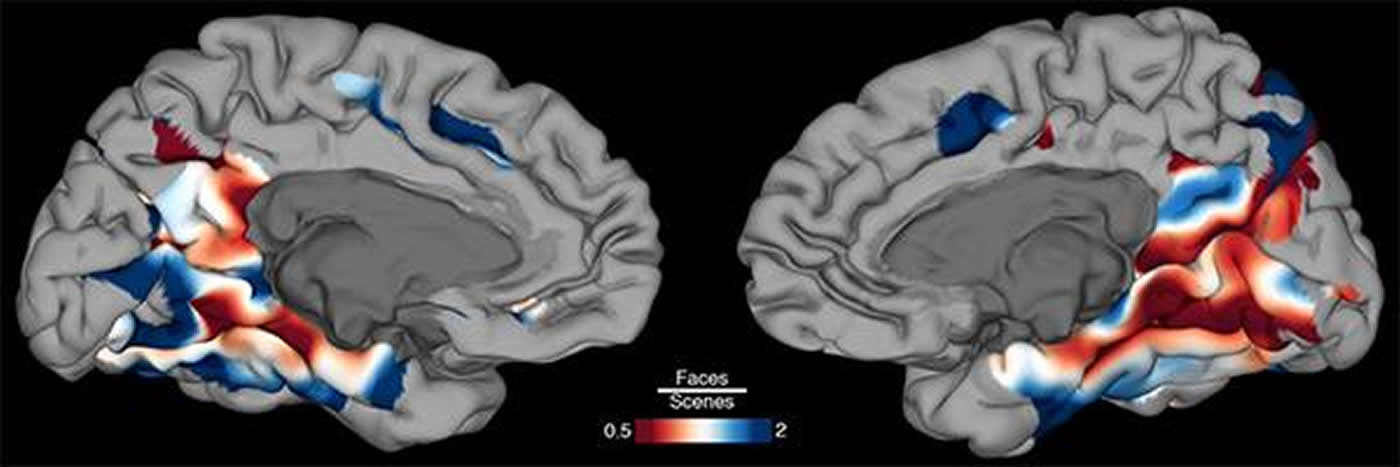Summary: The medial temporal lobe and medial parietal cortex work in tandem to assist in the recognition of faces and places.
Source: UT Houston
Using “sub-millimeter” brain implants, researchers at The University of Texas Health Science Center at Houston (UTHealth), have been able to determine which parts of the brain are linked to facial and scene recognition.
The study was published today in Current Biology.
“The ability to recognize familiar faces and locations is crucial to everyday life,” said Nitin Tandon, MD, lead author of the study and professor of neurosurgery at McGovern Medical School at UTHealth. “Identifying someone allows you to communicate with them and know who they are, and having this basic skill helps an individual attach an identity to those around them, making it easier to differentiate the who, what, and where.”
Traditionally, the hippocampus and parahippocampal gyri, located in the medial temporal lobe (MTL), are implicated as the main area for identification processes. However, recently it has become clear to researchers that the memory network responsible for identification extends beyond the MTL, including a region deep inside the brain called the medial parietal cortex (MPC).
To better understand how recognition and identification occur, researchers performed direct intracranial recordings in the MPC and MTL, structures that are known to be engaged during face and scene identification. In a cohort of 50 participants, a large number for this type of study, researchers placed stereoelectroencephalography (sEEG) electrode implants, used to identify epileptic seizures, in their brain and monitored their brain activity during several tests. This procedure in minimally invasive, involving the insertion of fine probes into the skull.
During these tests, researchers would show patients around 300 photos of celebrity faces and famous landmarks to determine whether or not they could name what they were seeing.
“One of the things that we were able to determine was that the MPC has specific regions involved in face and scene recognition,” said Oscar Woolnough, PhD, first author and postdoctoral research fellow in the Department of Neurosurgery at McGovern Medical School at UTHealth. “The MPC was preferentially activated when the patients recognized the people and places, exactly the same as traditional memory regions in MTL. We were also able to see how the MPC and MTL work together to help a person recognize faces and places.”

Research shows that this part of the parietal lobe where the MPC is located is an area of the brain that begins to deteriorate early in patients with Alzheimer’s disease. Identifying it as one of the regions of the brain that helps with memory and recognition shows researchers that areas outside of the traditional memory region, namely the hippocampus, are important to understand how abnormalities of the brain like Alzheimer’s affects a person. Tandon hopes this study can help with future advancements for other diseases.
“We are making many advances in understanding these very basic processes in the brain,” he said. “This will give us an opportunity to create devices and other technologies that will target abnormalities of brain processes in the future. So, in essence, what we are doing is creating an understanding of the software of which the brain operates in doing these basic functions. As technology advances, we hope to be able to implement such software, if you will, for creating solutions for abnormalities of brain functions. In this case specifically, the inability to recognize or retrieve somebody’s name.”
Other authors include Patrick S. Rollo, Kiefer J. Forseth, and Cihan M. Kadipasaoglu, MD, PhD, from McGovern Medical School; and Arne D. Ekstrom, PhD, with the University of Arizona. Tandon, Rollo, and Forseth are also associated with MD Anderson Cancer Center UTHealth Graduate School of Biomedical Sciences.
About this neuroscience research article
Source:
UT Houston
Media Contacts:
Jeannette Sanchez – UT Houston
Image Source:
The image is credited to Oscar Woolnough, PhD, postdoctoral research fellow in the Department of Neurosurgery at McGovern Medical School at UTHealth in Houston..
Original Research: Open access
“Category Selectivity for Face and Scene Recognition in Human Medial Parietal Cortex”. by Oscar Woolnough, Patrick S. Rollo, Kiefer J. Forseth, Cihan M. Kadipasaoglu, Arne D. Ekstrom, Nitin Tandon.
Current Biology doi:10.1016/j.cub.2020.05.018
Abstract
Category Selectivity for Face and Scene Recognition in Human Medial Parietal Cortex
The rapid recognition and memory of faces and scenes implies the engagement of category-specific computational hubs in the ventral visual stream with the distributed cortical memory network. To better understand how recognition and identification occur in humans, we performed direct intracranial recordings, in a large cohort of patients (n = 50), from the medial parietal cortex (MPC) and the medial temporal lobe (MTL), structures known to be engaged during face and scene identification. We discovered that the MPC is topologically tuned to face and scene recognition, with clusters in MPC performing scene recognition bilaterally and face recognition in right subparietal sulcus. The MTL displayed a selectivity gradient with anterior, entorhinal cortex showing face selectivity and posterior parahippocampal regions showing scene selectivity. In both MPC and MTL, stimulus-specific identifiable exemplars led to greater activity in these cortical patches. These two regions work in concert for recognition of faces and scenes. Feature selectivity and identity-sensitive activity in the two regions was coincident, and they exhibited theta-phase locking during face and scene recognition. These findings together provide clear evidence for a specific role of subregions in the MPC for the recognition of unique entities.
Feel Free To Share This Neuroscience News.






